SEO Copywriting: How to Write Content For People and Optimize For Google
SEO Copywriting: How to Write Content For People and Optimize For Google
If you want to build your blog audience, you’re going to have to get smarter with your content.
One of the biggest challenges that bloggers and content marketers face is writing content that’s optimized for search engines, yet will also appeal to people.
According to Copyblogger, SEO is the most misunderstood topic online. But, SEO content isn’t complicated, once you understand that people come first, before search algorithms. SEO firms make their money understanding these simple concepts.
Thriving in your online business means that you must go beyond simply “writing content.” Your content needs to accomplish two goals: first, appeal to the end-user (customers, clients, prospects, readers, etc.) and second, solve a particular problem.
But, how do you create content that meets those goals? How do you create content that ranks well with Google and also persuades people? That’s what SEO copywriting is all about. Don’t worry if you can’t afford an expensive SEO copywriter. You can do this following simple rules.
And, that’s what you’re going to learn in this article. It will cover:
- What is SEO?
- Understanding Copywriting
- What is SEO Copywriting?
- Elements of SEO Copywriting
- Writing Useful Content For People
- Keyword Research for Content Creation
- Copywriting – Getting People to Act
Let’s get started…
What is SEO?
We all know what happens when you type a search query into a search engine and hit “enter”: You get a list of search results that are relevant to your search term.
Those results pages appear as a result of search engine optimization (SEO). In a nutshell, SEO is a method of optimizing (enhancing the effectiveness of) your content for the search engines, in order to help it rank higher than content from other sites that target the same search terms.
Alpha Bee Design gives a clear picture of the SEO process:

Step by step, then, SEO is when:
- You research keywords …
- Then select a particular keyword and …
- Use that keyword to write content …
- Which other people then read and share on Twitter, Facebook, their own blogs and other social media platforms.
According to Redevolution, Google displays web pages in their search results based on the authority and relevance of the page to enhance the user experience. How does it measure authority and relevance?
- Google determines the relevance of your page by analyzing its content based on several factors, including where and how often you use certain words in that piece of content.
- Google measures authority by the number of links pointing to that page and how trustworthy those links are.
On the internet, links are like votes, with a slight difference. The winner of the election is determined solely by the number of votes, whereas your web page’s rank doesn’t depend so much on how many incoming links it has (quantity), but rather on the quality of those links. You and your marketing team need to understand this.
Quality has become the #1 ranking factor in Google, especially since the Google Panda and Penguin updates.
If you want more information on SEO, check out The Beginner’s Guide To SEO and The Advanced Guide To SEO.
Understanding Copywriting
Copywriting is the art and science of creating content that prompts the reader/end-user to either buy a product, subscribe to a list, take a test drive or take some other action that will benefit you.
Copywriting is salesmanship, says Bruce Bendinger. His definition of copywriting will make you smile:

Who drives a user to take action? A copywriter does. A copywriter is a skilled professional who writes copy for advertisements, promotions and customer engagement. In the marketing world, they’re often referred to as “creatives.” An SEO copywriter tailors this to online content.
A copywriter is someone who understands people, knows what his audience likes and chooses the words that will appeal to them. The headline, words, phrases, sentences and paragraphs used in the content have to persuade and cause readers to take a specific action. An SEO copywriter also understand how Google feels about certain words and phrases, especially long tail phrases.
If you’re a blogger, freelance writer or online business entrepreneur, you can become a sought-after copywriter when you develop your creativity and perfect your writing skills.
If you want to build a thriving online business and survive in this changing world of SEO, your job is to create useful content that’s interesting, persuasive and well-optimized for search engines — and you have to do it consistently. That is part of the user experience, getting new fresh content on demand.

What is SEO Copywriting?
SEO copywriting has evolved, since Google started rolling out their updates.
If you want to create highly useful content that ranks well in Google and simultaneously funnels paying clients or customers to your online business, you must think about the components of Google’s Ranking Algorithm.
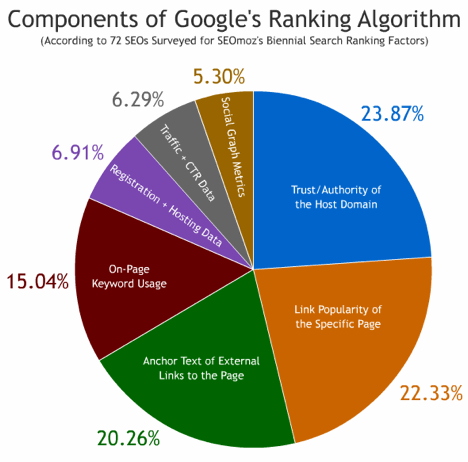
SEO copywriting is all about creating useful, compelling and valuable content that targets specific keywords so that other people will gladly promote it on social media platforms. This increases the authority and relevance of your content and improves its ranking in Google for the selected keywords. So when you highly recommend something, Google sees it relevant and you will achieve greater SEO content results.
SEO copywriting helps you target your customers and solve their specific problems with well-crafted content.

Step #1: Elements of SEO Copywriting
Certain elements of valuable content, such as visual appeal and timeliness, are the hallmarks of copywriting grace.
Implementing SEO best practices consistently throughout your content will naturally push your content to the Google top 10 and increase your traffic.
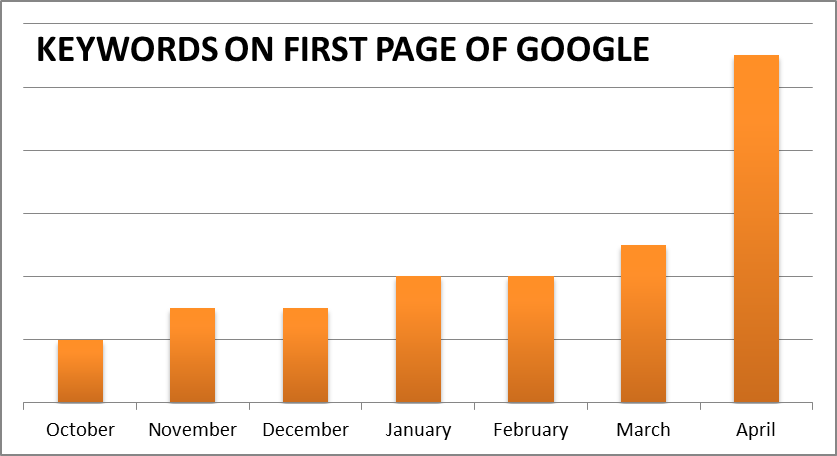
However, there are elements that will always enable you to rank highly in Google, as well as increase your conversion rate. Before you implement the elements of SEO copywriting, remember that there are things that should come before on-page optimization.
Here are the 6 elements of SEO copywriting that matter:
1) Site Speed
A study by Akamai revealed these stats:
- 40% of people will abandon a web page if it takes more than 3 seconds to fully load.
- 47% of end users expect a web page to load in two seconds or less.
Site speed has been a ranking factor since 2010 and it’s good for users, too. If your load time is more than 2 seconds, which is the standard load time for sites, then you should take steps to improve it.
That’s because if your content is useful and interesting, but it takes a long time for your page to load fully, your visitors will leave, because their attention span is short. They leave because of a bad user experience.
How do you measure your site load time? Follow these basic steps — I’ll use Psychology Today as an example:
Step one: Use Pingdom’s website speed test.

Step two: Analyze your site speed. Then, click the “History Tab”

You see that Psychology Today is fast. The load time is 1.97 seconds, beating the standard load time by 0.03 seconds.
Step three: Check the history. You want to determine the previous load times for your site.
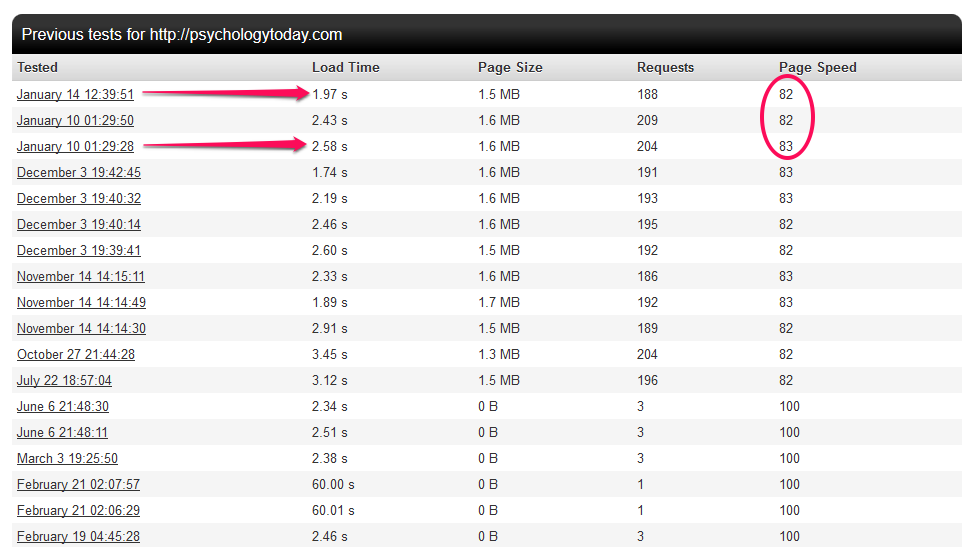
In our example, the history shows that Psychology Today had a load time of 2.58 seconds on January 10, 2015. The page size was 1.6 MB at the time. But today, the page size has been reduced to 1.5 MB and the load time improved to 1.97 seconds. This is what SEO firms check first and so should you.
Go ahead and check your site load time using Pingdom.
If you want to improve your site speed, read these step-by-step guides:
- 10 Ways To Improve Your Site Speed – And Improve Conversions By 7%
- Performance Unleashed: How To Speed Up WordPress Load Times
- 11 Low-Hanging Fruits For Increasing Website Speed (with Conversions)
Does site speed lead to improved conversion rates? Yes it does.
According to Kathryn Aragon, speeding up your site’s load time can improve your conversions by 7%.
And, this case study reveals how Smashing Magazine experienced an impressive boost in their conversion rate when they cleared their database of all of the clutter that old plugins had created, then merged all of the databases into one.
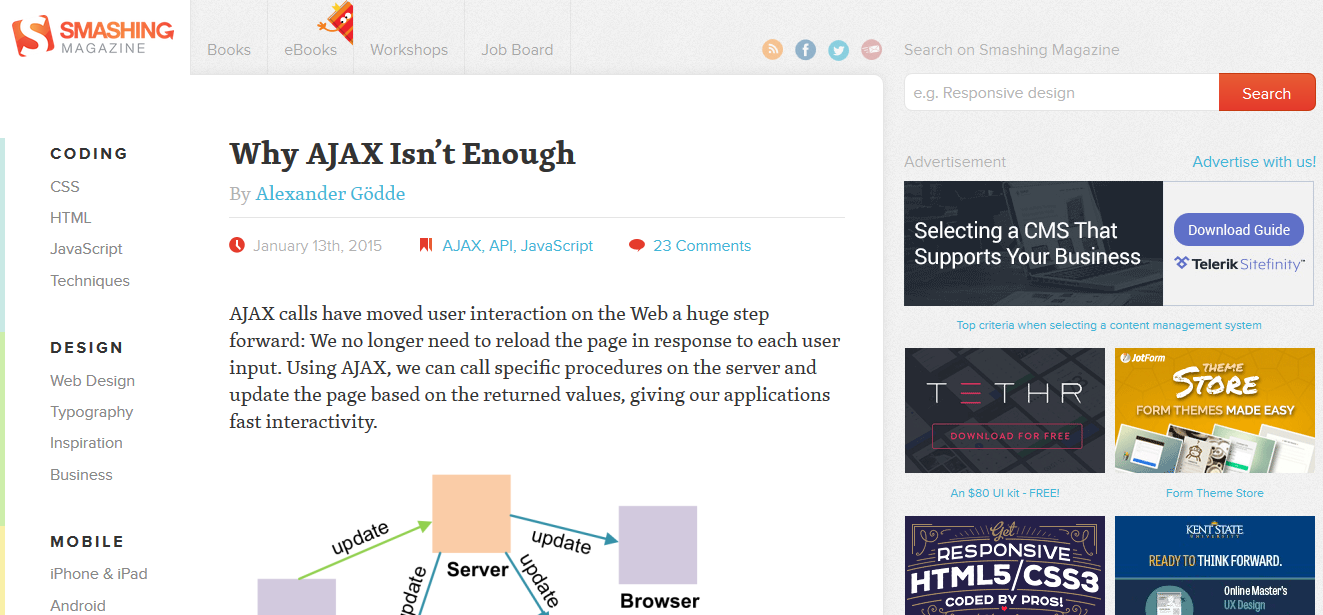
2) Headline
Your content may be valuable, but if your headline is mediocre, your click-through rate will be low. Don’t waste valuable SEO copy.
On the average, five times as many people read the headline as read the body copy. When you have written your headline, you have spent eighty cents out of your dollar. —David Ogilvy
Impression Marketing noted that a lot of bloggers and SEOs spend 55% of their time on content marketing: creating content, monitoring social signals and consumer reactions, tracking analytics, etc. But, how much time do you spend crafting the perfect headline?
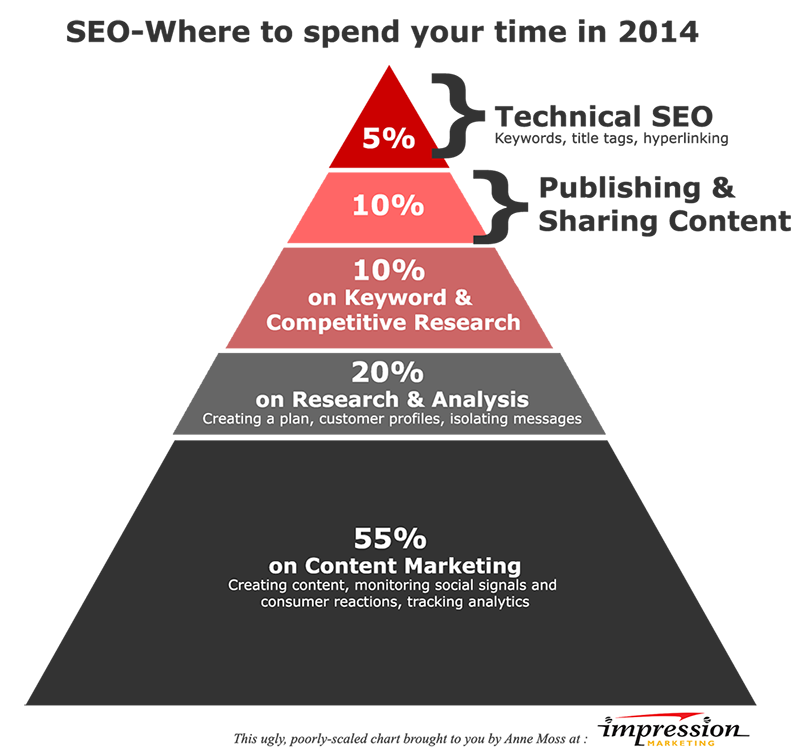
In SEO copywriting, your headline should attract people’s attention, then prompt them to click and read further.
As you learn to become a better writer, focus on the things your leads will see first. Such as the headline.
When you rank in Google’s top 10, if your headline is clickable and attractive, it doesn’t really matter whether you rank #1 or #4, because you will still attract organic visitors to your site. As a rule of thumb, a successful SEO copywriter creates the headline before moving on to the body of your article or blog post.
Note: Headlines that convey a specific message or idea work best with search users. According to Conversion XL, headlines with numbers are always winners so, if it makes sense, include a figure in the headline.

Several authority content sites use numbers in their headlines. Three out of 5 post headlines use numbers on Lifehack. Sites like Inc, BusinessWeek, Mashable and Upworthy all understand the psychology behind numbers.
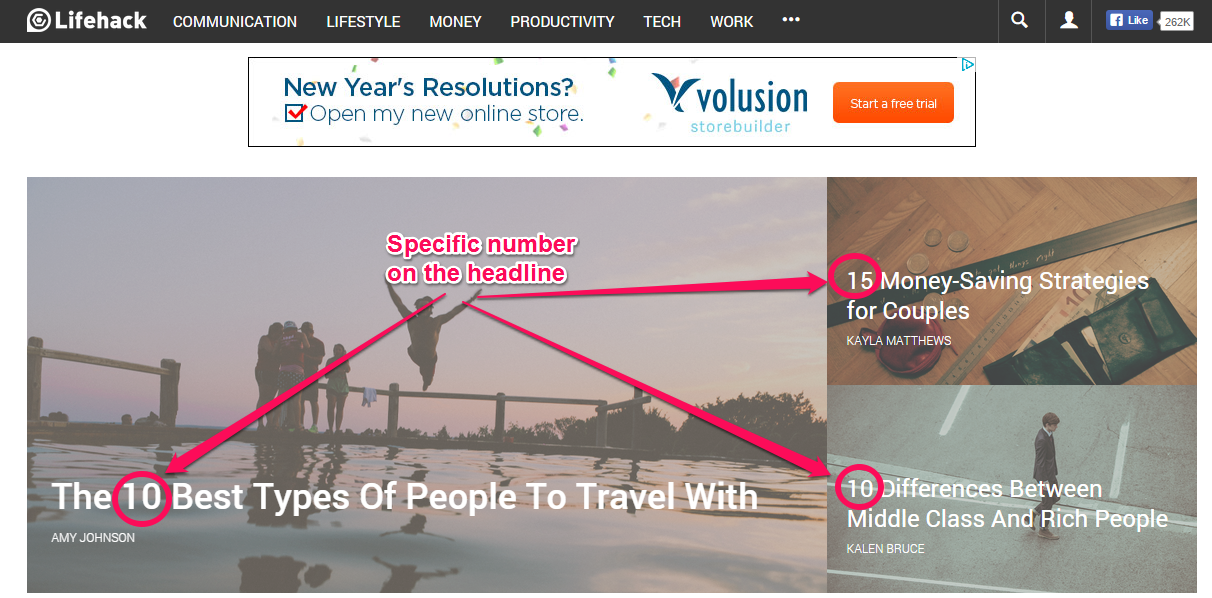
Headlines that have numbers in them usually get shared more on Facebook and Twitter, as well. For example, the second most popular post on HubSpot is a number-type headline with over 10,000 tweets to date.

Generate article ideas: If you’re stuck and don’t know what to write about, you can use the Inbound Now tool to generate blog post/article ideas before you hire that SEO copywriter.
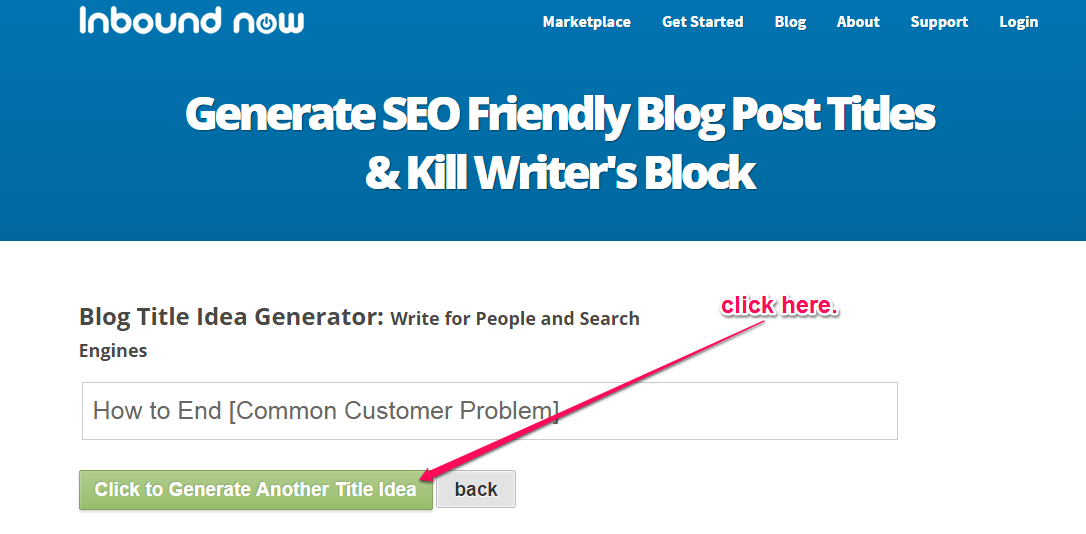
There are several resources for writing click-worthy and sharable headlines. To demonstrate, let’s write some fresh headlines in three popular industries: small business, fitness and relationships.
Clickable and optimized small business headlines:
- 7 Small Business Trends That Will Affect Your Sales
- How To Start a Small Business That Customers Will Love
- Small Business Funding: How To Raise $20,000 In 60 Days
SEO and user-friendly fitness headlines:
- 10 Workout Secrets For Women That Work
- Best Way To Lose 10 Pounds After Pregnancy
- Personal Trainer Kits: Become a Certified Personal Trainer
Well-optimized and catchy “relationship” headlines:
- 3 Funny Ways To Get Your Ex-Boyfriend Back
- How To Renew Your Love Life with Your Spouse
- What Does It Take To Have a Fabulous Wedding?
Analyzing the search engine results: Let’s say that we do a search in Google for “save money.” You can see that most search results are SEO-friendly (and target a keyword), but some of the headlines themselves are not attractive to the user. Adding a long tail to the title might help for those with specific inquiries.
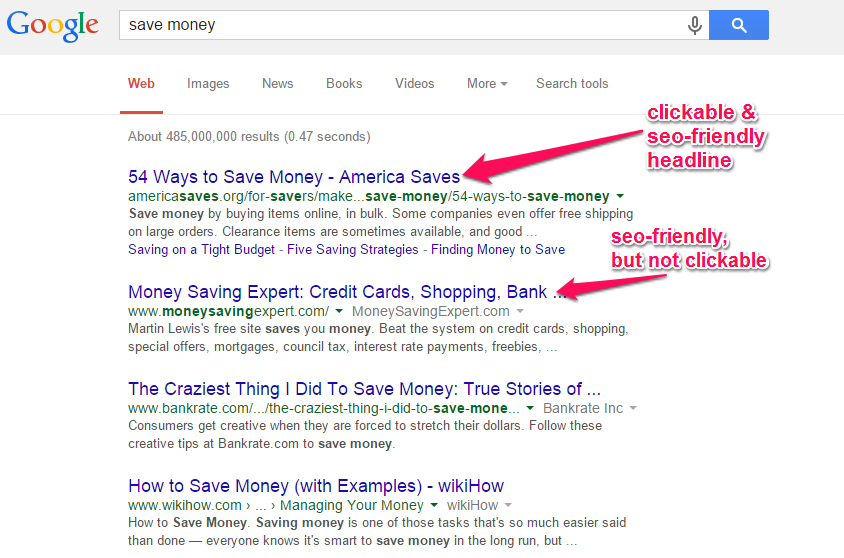
New and experienced SEO copywriters highly recommend downloading Yoast SEO as a WordPress plugin to help optimize SEO copy. Once you learn SEO copywriting, you can write content that will both rank highly in Google result pages and also attract clicks from prospective customers or clients.
Note: If you want your whole title to be visible in search engine results, keep it under 72 characters. This will also increase your click-through rates.
3) Content
The content itself is a vital element of SEO copywriting. The major reason why people conduct searches in Google and other search engines is that they’re looking for useful content. Search engines also feed on fresh SEO content, which is why you must consistently update your site.
Marcus Sheridan grew his swimming pool company from less than 10,000 to 80,000 monthly visitors, within 6 months and he grew his organic traffic by blogging 2 -3 times a week.
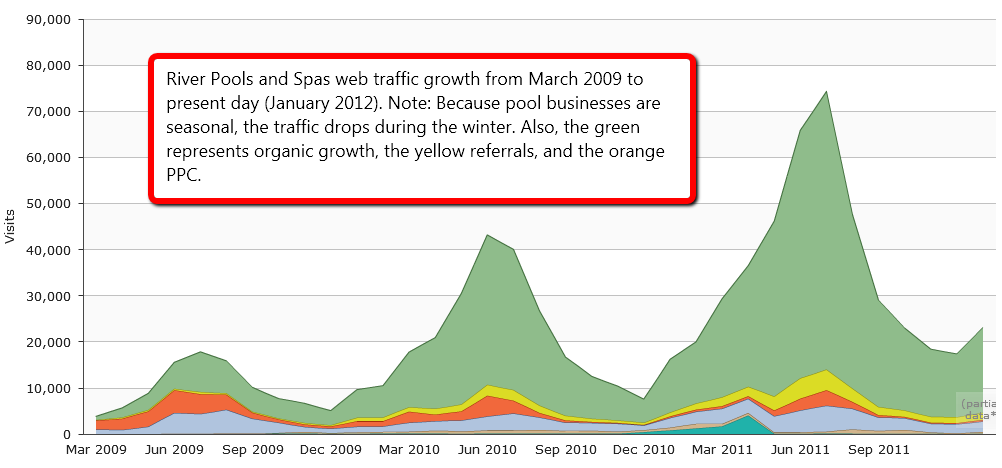
When Marcus began to target long-tail keywords in his blog posts, everything changed. He said that “within hours of writing an article with specific keyword goals, we were showing up on the first page of Google.”

If you want to write the best content that will rank well in Google, you have to target keyword phrases. Avoid stuffing keywords or over-optimization. Ideally, put the keyword in your headline, but make sure that it reads smoothly for your readers.
The Google Panda 4.1 update was designed to penalize “thin” or shallow content, by keeping lousy content from ranking highly in Google. A typical blog post or article should be at least 1000 words. But, it’s not all about length, because several detailed articles still struggle to rank and retain their position in Google results pages.
Before you write your SEO content, it’s essential to understand your reader. Then, niche down and focus on a particular problem that the reader is struggling with. Dare to solve that problem with your content – that’s another goal of combining SEO and copywriting.
Every piece of content you write needs a compelling introduction. The introduction is the portion that comes right after the headline (and sub-headline if you include one in your content). Your introduction should contain at least one of your targeted keyword phrases, especially a long tail keyword.
However, it’s crucial to understand that modern SEO copywriting has gone beyond keyword targeting and placement. The best approach now is to write content that addresses keyword intent. You will learn about that later on…
4) Meta Description
Before writing your content and again, before publishing it, use meta descriptions to help guide search engines. Meta descriptions help search engines and searchers understand what the topic is and why your targeted keywords and phrases keep appearing in the content. This is where SEO firms earn their money, only because they understand this.
Moz noted that the meta description is the HTML attribute that provides a “concise explanation” to the search engines of your page’s content. The tag is enclosed with the <head> section </head> on your web page. This is the code sample:

Google uses the meta description on your page as a snippet when people search for keywords that are relevant to your page. This snippet copy is what will determine whether or not you get clicks, no matter how highly you rank in the search results.
For SEO purposes, the meta description should be 150 – 160 characters and usually appears like this in Google:

Note: If you own a WordPress blog, you can install the All-In-One SEO Pack plugin and use it to set up your title, meta description and relevant keywords. If you’re new to blogging, this guide will help you set up the plugin.
The Big Question: How do I write meta descriptions that catch people’s attention, as well as rank well in Google?
Step #1: Understand keyword intent. Keyword intent is the main purpose or reason behind keywords (whether seed or long-tail keywords).
For example, say you’re a social media consultant and you want to attract clients to your business. Then, your primary keyword might be “social media expert advice.”
When prospective clients type that keyword into Google search, what do you think they’re really interested in?
What they want is clear – a social media expert with advice on how they can move their online or brick-and-mortar business to the next level.
Maybe they want more Twitter followers, greater engagement or tips on how to acquire more leads. Your meta description has to be relevant and appeal to them.
Step #2: Once your article or blog post has been written, the next thing is to write your meta description. Swell Path recommends you follow this checklist:

To demonstrate, let’s put the tips to work, by writing two meta descriptions that are SEO friendly and relevant to our target audience.
a) Begin with a question: Looking for expert social media tips to acquire new leads, convert visitors to customers and improve your brand? First, set a definite goal.
Length – 141 characters.
b) State the obvious: Many companies have given up on social media marketing, because they don’t know what to do. All you need is expert advice that has produced success.
Length – 148 characters.
Note: You don’t necessarily need to include your exact keywords in your meta description, especially when it doesn’t flow smoothly. I’ve seen a lot of web pages rank in Google’s top 10 without the main keywords.

5) Keyword Frequency
Keyword frequency means how many times your chosen keywords appear on the web page.
For example, if your target keyword is “best london hotels,” how many times will this exact keyword phrase appear in your 300, 500 or 1000+ word article? In contrast, keyword density is concerned with the ratio of “best london hotels,” to other words on the same page.
Keyword frequency and density are no longer as effective as they used to be, before Google started rolling out frequent updates, but are still important parts of SEO content. Avoid on-page optimization mistakes, like keyword stuffing, excessive keyword insertion and header tag stuffing.
However, keyword density still impacts organic ranking to some extent. According to Brian Dean, keyword density/frequency is one of the 200 ranking factors, which means that you should still consider it. But, don’t go overboard.
Here’s what Brian Clark had to say about it:
The only way to tell if your repetition of keywords is super or spammy is to measure that frequency against the overall length of the content. A keyword density greater than 5.5% could make you guilty of keyword stuffing and your page could be penalized by Google. You don’t need to mindlessly repeat keywords to optimize. In fact, if you do, you’re likely to achieve the opposite result.
To check your keyword density, use the SEObook keyword density tool.
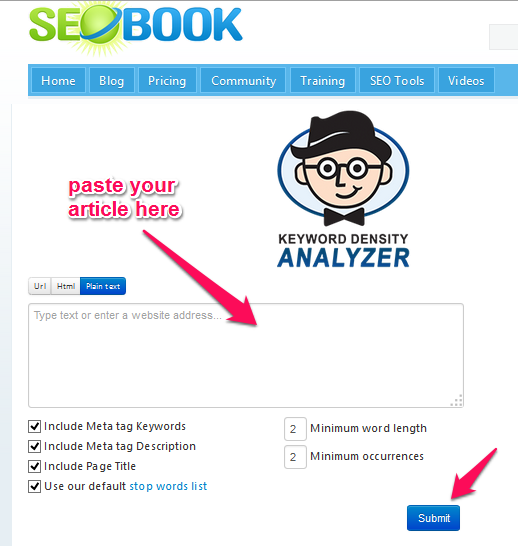
6) Page Links
Links are the basic building blocks of your web page. One of the 10 things Google knows to be true is that “there’s always more information out there.”
Page links tell Google that you’re connected and sociable and that you’ve got useful content that people can access somewhere else. This content could be your own or it could be from another author or site.
Linking out to other authority sites and pages is an indication that you value what other people create. Google will reward you for being in sync with their mission: organizing the world’s information and making it universally accessible. A good marketing team would highly recommend to appropriately link.

What copywriters usually do is to find appropriate keywords, research accurate data and then use both to craft irresistible content. That’s why copywriting is one of the fundamental factors of search engine optimization.
The rules for linking out to other sites are not set in stone. There are also no hard and fast rules for internal linking. However, as a smart online marketer who wants to achieve tremendous results in the search engines, you should:
- Link to relevant pages within and outside your site in your introduction
- Link to more in-depth guides or content on your page or other sites
- Link with appropriate anchor text, which flows naturally with the content
As I said earlier, these rules are not set by Google or other search engines. If you can understand your target audience and you produce the best content that will solve your readers’ problems, you don’t need to worry about keyword density, page links and social signals, because they will occur naturally.
Remember that highly useful content will always attract thousands of social shares, comments, leads, clients and sales. This is your job as the SEO copywriter.
SEO Copywriting Tools & Resources: To fully understand and implement SEO copywriting best practices, you need viable tools and resources. Here are some that I recommend:
Unsuck-it: This is a free web app that you can use to make your words, sentences and paragraphs flow smoothly. You can replace jargon with fun words in five seconds.

RhymeZone: A lot of people love reading poetry and admire poets. Use this handy tool to make your copy appealing to the right audience.
Read-Able: This simple tool helps you optimize your content for 7th – 8th grade level. This ensures that a wider audience will enjoy your content and click the headline when it shows up in Google results pages.
Live-Keyword-Analysis: Use this free SEO tool to accurately calculate the keyword density ratio for a piece of content.
Kill Writer’s Block: Highly recommend this tool to generate creative ideas for your next blog post.
Quick Sprout: Find out why you’re not generating enough traffic from Google, even when your long-tail keywords are ranking highly.
EMV Headline Analyzer: How much does your headline appeal to your readers’ emotions? Highly recommend this free tool to analyze your headline and give you a score.

Google’s 200 Ranking Factors: The Complete List – this one is self-explanatory.
For a list of other resources and tools that are useful for SEO copywriting, check out Writtent.
Copywriting optimization points: Search engine rankings can’t be predicted, no matter how knowledgeable you are, because Google is always updating their ranking algorithm. If you plan on hiring an SEO firm to create CEO copy, realize they are subject to a changing game as well.
However, there are actions that you can take to increase the likelihood of your web page showing up in Google for relevant search queries. Let’s explore those factors:
Title tags: It’s a good idea to know how to write title tags for search engine optimization. Again, Yoast SEO can help here. The title tag is a meta HTML tag, like the meta description we saw earlier. It is like the title of a book. It’s the first thing that appears in Google search results.

The title tag should be a concise and accurate description of your web page. Google will display 50 – 60 characters of your title in their search results. As well as thinking about length, write titles that will align with your brand.
Moz does highly recommend that the optimal format for your title is: Primary Keyword – Secondary Keyword | Brand Name
For example: Learn CSS online – CSS formatting Tips | WebDesignClub
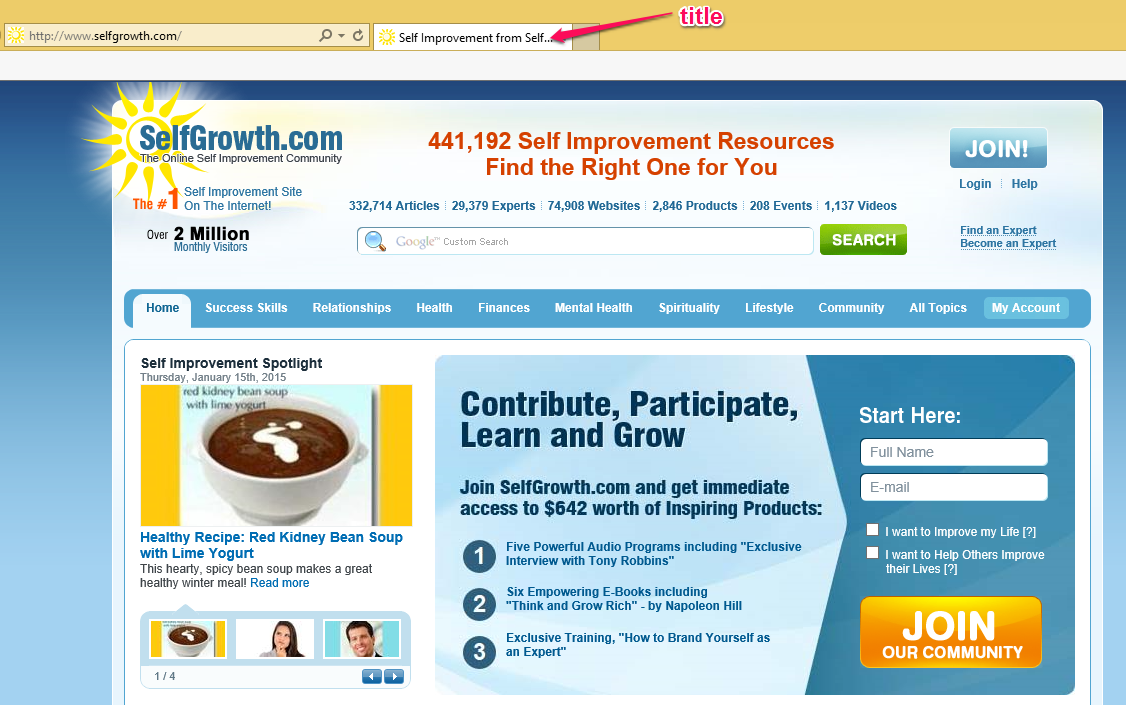
Heading tags: The heading tags are labeled h1 – h6. The heading tags will enlarge your font size and make it stand out. When you write content, it should be well structured for readers.
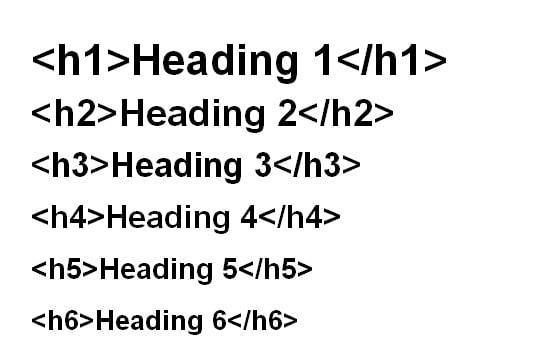
Optimizing your title: This is one of the most important things that you can do to ensure that your title ranks in Google, as well as attracting an audience. This screenshot of the Moz resource on title tags helps you optimize your titles effectively:
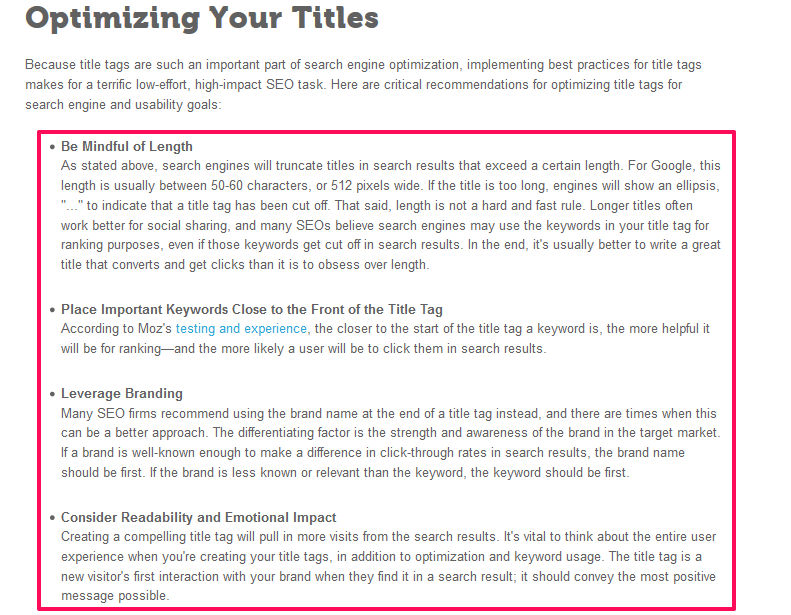
Step #2: Writing Useful Content For People
Words are powerful. Words drive engagement. If you can piece words together to produce a valuable piece of content, your target audience will love you for it — and they’ll stick around. There is no alternative to writing great content.
The number of blogs that produce fresh content daily is ever-growing. Remember that duplicate content, keyword-stuffed content and low-quality content will not help your target audience. This is not a good SEO content strategy and can’t be emphasized enough. It also won’t do a thing to improve your organic ranking.

A recent study shows that even if your content is useful, it still needs three additional elements, in order to drive organic traffic:
- Optimized for many keywords with lots of searches
- A reasonable number of trusted backlinks
- An evergreen idea/topic
That’s how Brian Dean increased organic traffic by 110% in 14 days.

Search users’ intent: Keyword research is still necessary. But, the most important aspect of any keyword used by search users is the intent. Before you can write great content that solves a particular problem, you’ve got to know what each keyword stands for.
Greg Meyers advises that you pay attention to keyword classification. In other words, understand whether search users want to buy a product or not.
There are two important keyword classifications: informational and commercial keywords.
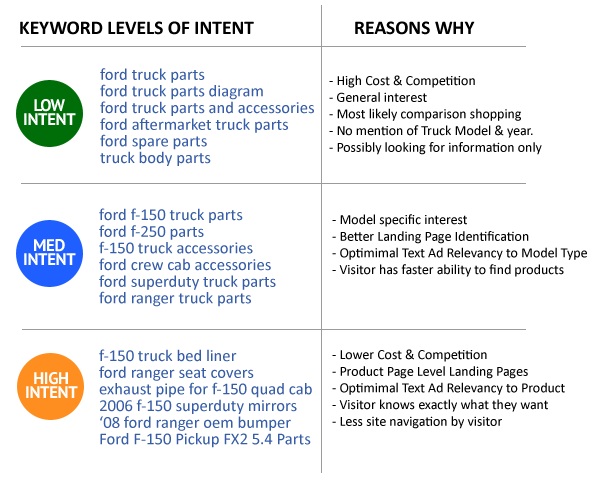
Informational keywords: The major reason why people search with these is that they want useful information without having to pay for it.
Informational keywords are usually “how-to” in nature. Here’s an example from Ubersuggest:
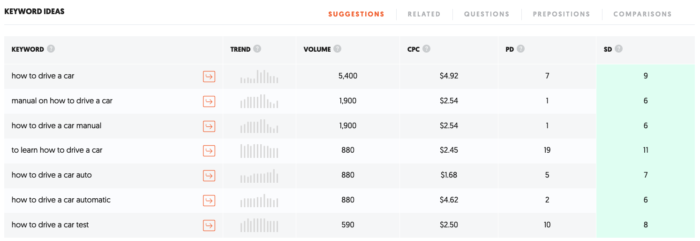
Of the seven keywords on this list, five of them begin with “how-to.”
These are informational because the searchers are probably only interested in free articles, videos, blog posts and lessons.
As an SEO copywriter, you can write useful content around informational keywords, but don’t expect to convert readers into customers, because most of them don’t want to buy. Instead, use informational keywords in your content to nurture an audience, engage them and build your brand.
Commercial keywords: Commercial keywords show an ‘intent’ to buy. These keywords usually show “desperation” from the searcher. They want solutions quickly – e.g., “lose 10 pounds in 3 days.”
The person searching for commercial keywords is likely going to buy a product, or sign up to an email list that will eventually convert them into customers.
The fact that someone typed a commercial keyword into Google means the person is ready to take action. Commercial keywords usually contain certain prefixes and suffixes, like reviews, buy, order, review, comparison, compare, free shipping, best, fast, etc. See this example in the weight loss niche:
Examples of commercial keywords from this list include lose weight gnc product, gnc product to lose weight, herbalife weight lose product, and herbalife product to lose weight.
Note: When you write content around commercial keywords, the ultimate goal is to provide useful information on how to use the product, its benefits and features and how to install it, if that’s required.
Should you target keywords? Yes. Google still uses keywords to gauge what a particular web page is about. But, use caution and avoid over-optimization.
I follow a 3-step plan, when targeting keywords in my content.
- I include the primary keyword on the headline. For example if my keyword is: conversion rate optimization. My headline maybe, 7 Ways To Make Conversion Rate Optimization Work For You
- I use alternative keywords in the introduction, meta description and title tags. For example, What is the best way to increase your conversion rate with every blog post that you write? You know how important this is, especially when it seems as though your best content isn’t generating organic traffic, social shares and sales.
- I write naturally to please my readers and then deliberately include the primary keyword in the conclusion.
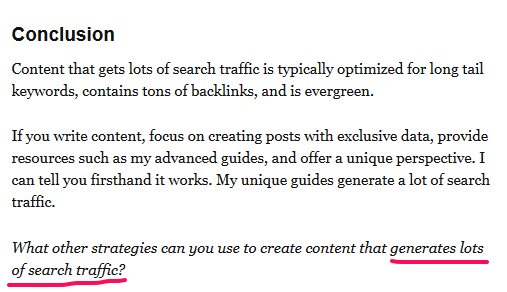
Storytelling: As an SEO copywriter, storytelling can set you apart, because human beings love good stories. If you can weave your brand story into your blog post, article or video, you will attract more attention.
Kzero research showed that storytelling has been the secret of exponential growth for several digital companies, like Google, Facebook, Netflix and even Zappos.

Brand storytelling is not something new. Several brands have used it in the past and still do. According to Kristen Matthews, when you use natural storytelling in your content, you can make the maximum impact on the reader.
I’ve shared the story of how a Ferrari made me a million bucks. Recently, I wrote a blog post on How Spending $162,301.42 on Clothes Made Me $692,500. So far, the two posts have been shared more than 2,000 times on Facebook, Twitter and Google+ combined:

A great example of a successful brand story is The Lego Movie. According to Marcus Sheridan, who is also a great storyteller, “Lego doesn’t sell ‘blocks’ at all, they sell possibilities.”
(Read the full story here: The Best Example of Brand Storytelling Ever: The Lego Movie.)

In other words, your story should show others the possibility of achieving the same results. Your story shouldn’t be about you alone, however. Instead, find a way to make it appealing to your target audience.
That’s when brand storytelling will help improve your organic ranking, traffic and sales conversions.
Humor: One of the reasons why you should write with humor is to keep the reader/audience engaged. You can also infuse humor to simplify an uncomfortable or controversial topic.
SEO copywriting is not just about writing useful content that solves a particular problem in a boring manner. Your content also has to excite your readers.
They should be excited to click your headline, read the introduction and then move slowly down the body. That’s what it means to write persuasively. If you can do that, it doesn’t matter what you create: people will love it. Whatever you highly recommend, they will buy.
Here’s an example. A professional blogger and public speaker who usually adds humor to her content is Marie Forleo. Each of her video intros always entertains me.
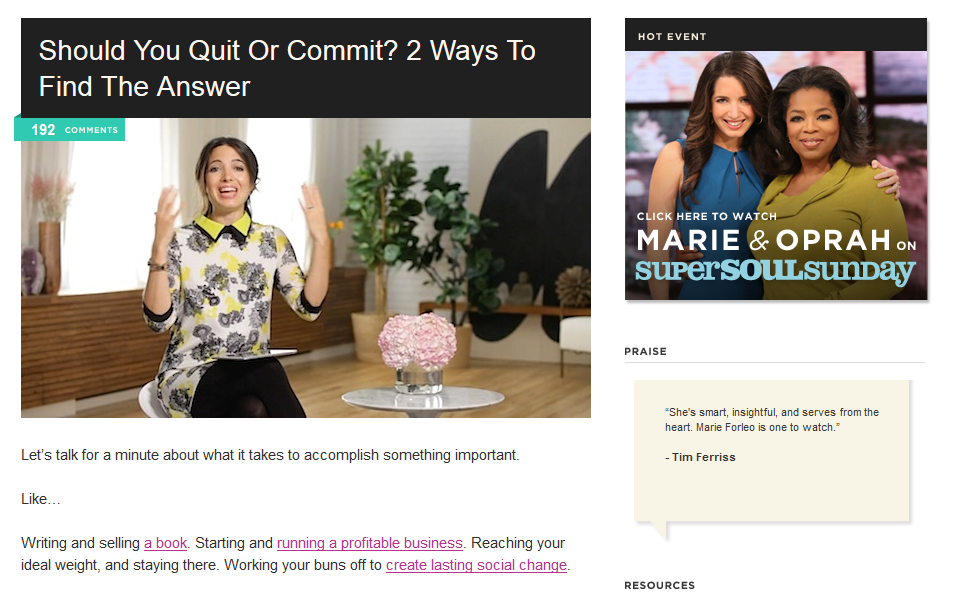
Case study: The case study is one of the 15 types of content that will drive more traffic to your site. Case studies can make for powerful content. I’ve seen them rank in Google’s top 10, because they’re highly useful.
A study at Content Marketing Institute shows that B2B buyers prefer case studies and research-based content.
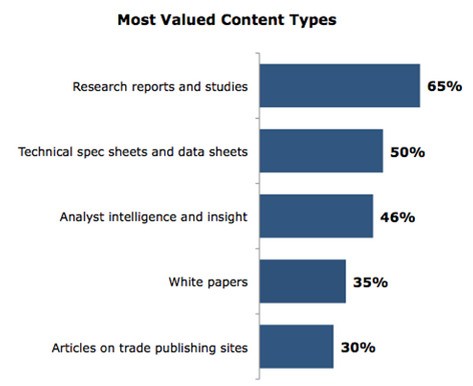
And, if you consistently write useful and detailed case studies, your major long tail keywords will start showing up in Google’s top 10 for relevant keywords.
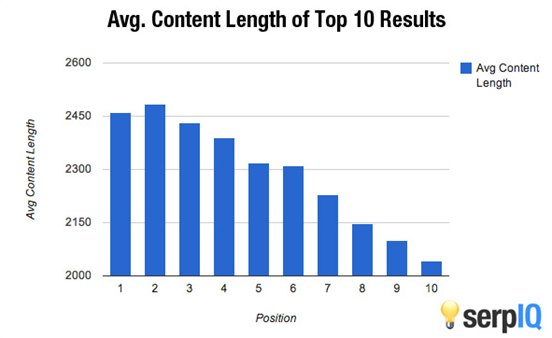
Case studies usually explain what your products and services are. A good case study will show the experiments, research studies and interviews that you conducted, as well as the results that you got. An SEO firm can help in analytics but isn’t absolutely necessary.
You can share any type of case study, even ones that didn’t get the results you hoped for. If you want to create a valuable and optimized case study, this screenshot will guide you:
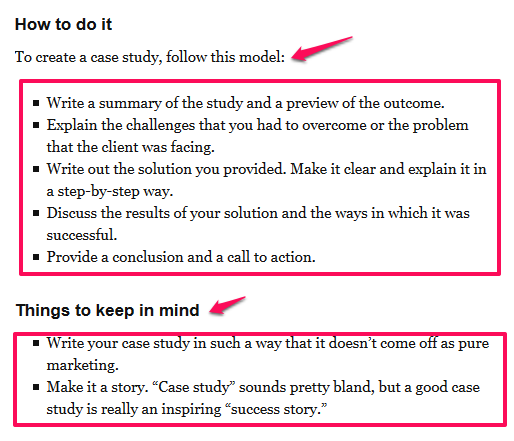
Step #3: Keyword Research for Content Creation
More than 66% of all clicks go to the top 3 search engine results. If you want to tap into this rare opportunity to rank in the top 3 positions, then you should learn keyword research best practices.
Long-tail keywords are the best way to go in modern SEO, because top brands are not targeting those terms. And, if you can produce good content while naturally targeting these types of keywords, you will definitely dominate the search engines.
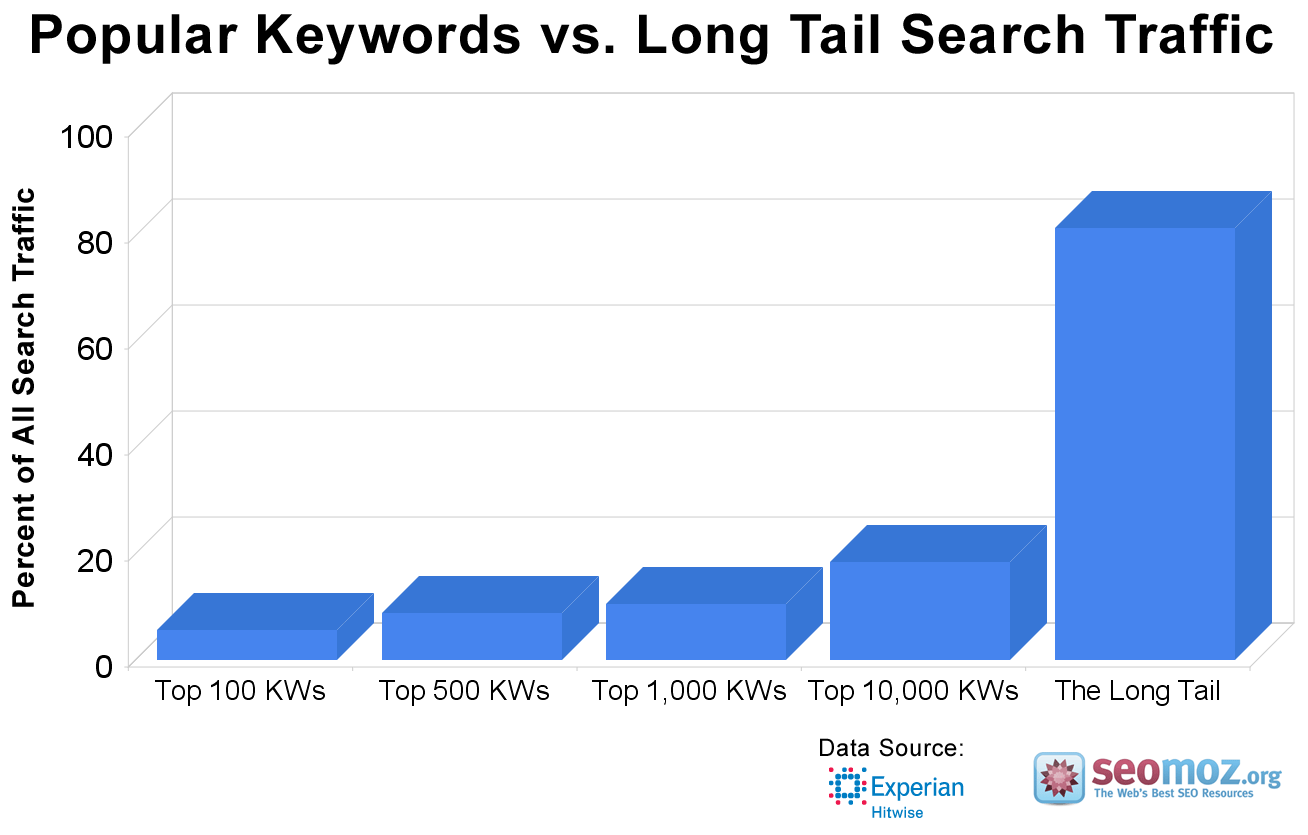
SEO isn’t complete without keyword research. That’s part of how you determine the mindset and intent of your target audience. Long tails help define that mindset.
In niche marketing, picking the right keywords is the most challenging aspect of building a profitable niche site.
Once you’ve chosen your topic, it’s time to find relevant keywords in that industry. Let’s find keywords for “waterproof digital cameras.”
Go to Ubersuggest. Plug the topic into the search box, then click “Search.”

Here’s what the search returns:
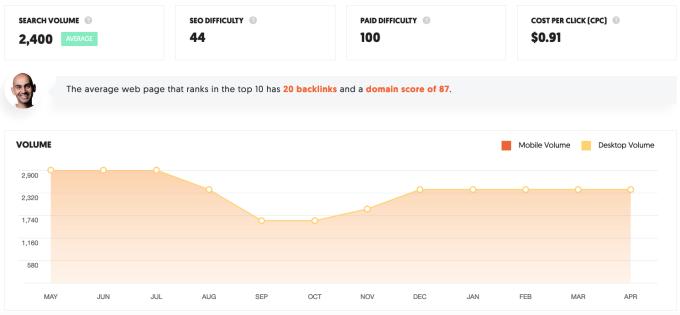
- Search volume – number of searches the keyword has during a month
- SEO difficulty – estimated competition in organic search
- Paid difficulty – estimated competition in paid search
- Cost per click – average cost per click for a Google Ad
You’re also provided an overview of what it takes, on average, in terms of backlinks and domain score, to reach the first page of Google for the keyword. This is located above a chart displaying the keyword search volume over the past 12 month period. Pay close attention to any dips in traffic. For this particular keyword, it’s natural for volume to drop off during the fall and winter months.
As you scroll down the page, you’ll find a list of long-tail keywords that we can optimize our content for:
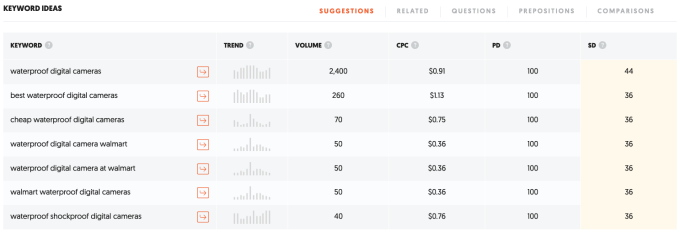
From this list, “best waterproof digital cameras” is a good choice, as the search volume is still high enough to move the needle.
Optimizing content for search robots: Search engine robots or web robots (e.g. crawlers, spiders and so on) are programs that constantly scour the web.
When a Google spider crawls your web page, it’s looking for fresh content. Some people even say that spiders/crawlers feed on fresh content and will reward you for freshly updating your site regularly.
However, understand that when Google spiders index (add your fresh content to their search database), they’re only interested in the meta tags (title tag and meta description).
More importantly, they want to know the keywords that you’re targeting. This helps Google determine the industry your content will benefit, e.g., health, business, small business, internet marketing, etc.
For best results, you should optimize for search robots like this:
- Add the primary keyword in your title tag and meta description, once.
- Add alternative keywords in your introduction and make sure that it flows well. If the keyword doesn’t flow well, ignore it and just write naturally.
Keywords like “best seo web design NY” won’t work in the title tag, description and content. The best approach is to use the keyword naturally, like this:
How To Find The Best SEO Firm and Web Design In NY
On-page optimization: On-page SEO doesn’t have to be tedious or complicated. A lot of posts have been written to address this topic.
Elements that add value to your site, such as internal links, are very important.
You control 98% of what happens within your site.
That’s why Google pays attention to your web pages and measures the engagement, bounce rate, retention rate and social shares.
The foundation of an effective SEO campaign is what happens in-house (on your site). In other words, pay attention to how you target your keywords, which anchor is used to link internal pages, meta tags, etc.
This on-page optimization infographic from Backlinko will show you what matters, when it comes to creating SEO-friendly content pages.

Click here to view the full size.
Off-page optimization: In today’s digital marketing, the public determines how relevant and useful your content is. And, Google uses the off-page factors to gauge the authority and value of your content pages.
Generally, you can’t control what happens outside your site. For example, you don’t control who links to you and you don’t control the quality of sites that choose to reference your work.
But, if you’re smart, you can use off-page SEO techniques to build a solid brand online and increase organic traffic.
According to Chris Ainsworth, the 5 proven off-page SEO strategies that work well are:
- Build and engage a raving community through social media
- Expose your business and take advantage of local
- Instill brand confidence through business reviews
- Promote local citation and Name/Address/Phone (NAP) consistency
- Link building through: blogging, guest posting, competitor link analysis, blog outreach & networking and dofollow blog commenting.
Step #4: Copywriting – Getting People to Act
The final piece of the puzzle in this in-depth article is “persuasion” — the ability of your copy to drive people to action. This isn’t difficult, because there are many high-quality resources and tools that you can use.
Copy is written to sell a product, service or an idea. But, it all begins with selling yourself, because you’ve only got a maximum of 30 seconds to sell yourself and leave people wanting more.
Use bullet points: One of the ways to push people into action is to highlight the key points of your content or topic using bullet points. Before you write blog posts or articles, Vivian Giang recommends you list 3 or 4 strong benefits that you will cover. This is very important, as it also helps you create powerful headlines and paragraphs.
Derek Halpern, founder of Social Triggers, a giant SEO firm, combines the power of psychology and copywriting to produce compelling content. He also employs the same strategy on his landing page.
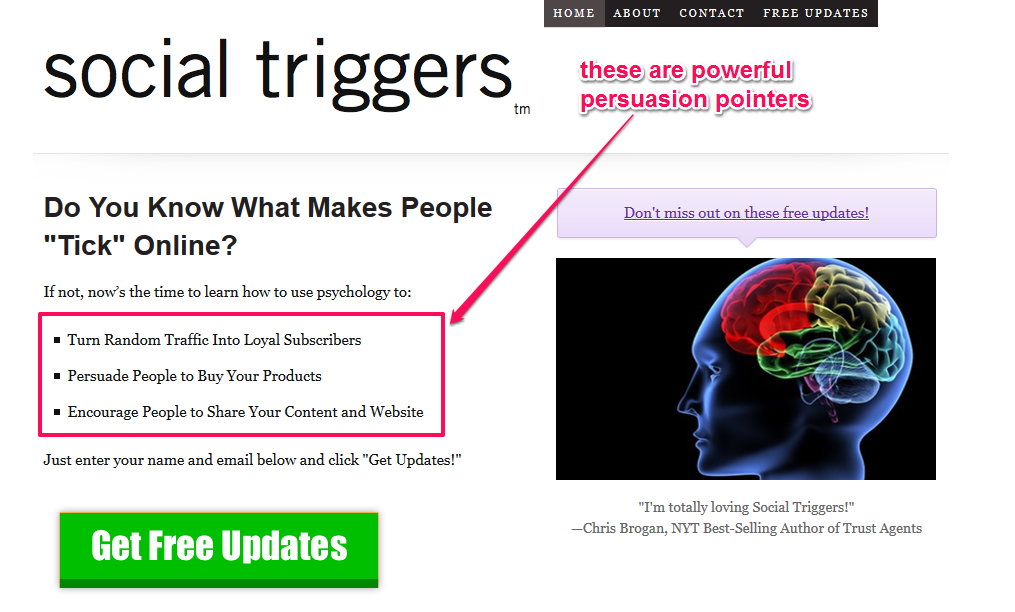
Create irresistible and valuable headlines: Columbia University recognized headlines as the most important element of copy. They advise that you think like a reader and write the headline first. The headline should target a keyword and also look attractive.
Let’s craft more clickable headlines, using some of the results in Google. When I search for “diet plans,” here are the results I get:
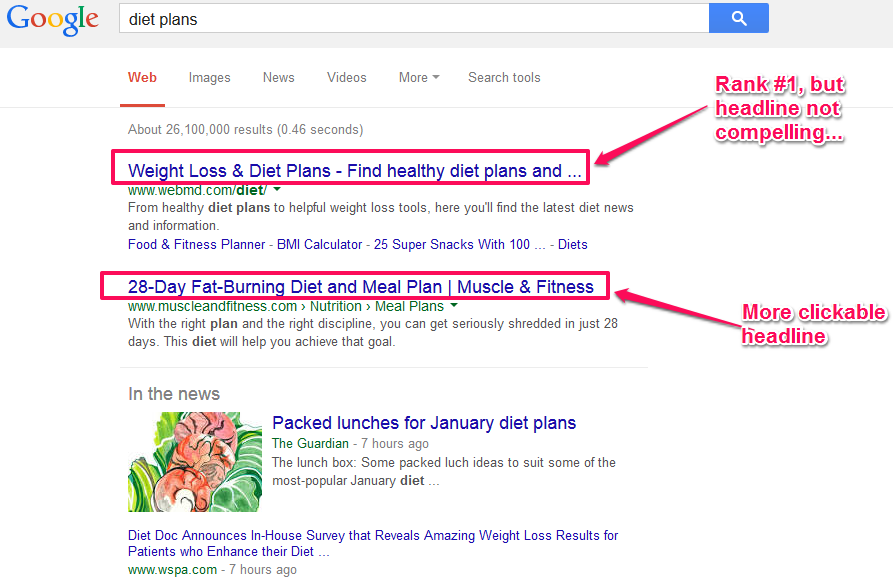
The screenshot above shows the headlines showing up at #1 and #2 in Google for the keyword “diet plans.”
Original headline:
Weight Loss & Diet Plans – Find Healthy Diet Plans And…
Here’s a much better headline:
The Best Diet Plans To Help You Stay Fit
7-Day Weight Loss Diet Plans For Women
Original headline:
28-Day Fat-Burning Diet and Meal Plan | Muscle & Fitness
Let’s make the headline more compelling and useful:
28-Day Diet Plans That Will Help You Burn Fat
BodyBuilding.com has compelling, catchy headlines that are the right length (50 – 60 characters) and target a particular keyword.

Have clarity of purpose: Getting clear with your copy, blog post and message is very important. Wider Funnel increased their conversion rate from 10% to 277%, just by implementing clearer call-to-action buttons and reducing the number of form fields.
When you write content for your blog, focus on one idea and write your post to address a challenge, solve a problem or explain a complicated issue.
According to Success Consciousness, here are some of the ways that you can achieve clarity of purpose as you write your content:
- Know exactly what you want, before you write it — e.g., How to Save $100 in the Grocery Store.
- Use the word “you,” when writing for B2C customers and “we,” when your recipients are mostly business organizations.
- Research accurate data that are relevant to your topic. This study by Conversion XL shows that using a data-driven approach and creating infographics that have accurate data points will improve social shares.
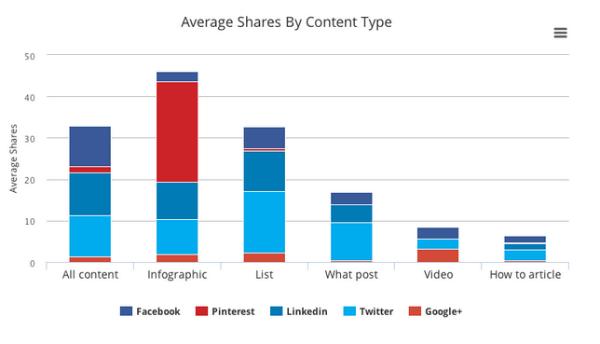
- Target 2 – 5 keywords in a blog post and ensure they read naturally. See an example below. If you read it aloud, you will notice how the keywords flow smoothly with the rest of the content.

Conclusion
I’ve used these SEO strategies to increase my blog’s traffic by 203%. Even if you don’t achieve the same growth rate, you will absolutely generate more traffic, improve your brand and fall in love with content marketing.
If you’re not leveraging “persuasion” and “psychology” to improve organic rankings and captivate your audience, I highly recommend that now is the best time to start.
- Keyword research: The Beginners Guide
- SEMrush: A Practical Guide For Growing Blog Traffic
- Best Keyword Research Tools For SEO: Latest Edition
How to Start Writing SEO-Optimized Articles
Step 1- Start with research
- Keyword to target
- Length of the article
- Type of the article
- Analyze existing articles for outline
- People also ask questions
Step 2- Type of content: Keyword Search Intent

Step 3- Find the idle Length of the article
- Login to SEMrush dashboard (Get 14 days free trial here)
- Under On-page & Tech SEO > SEO content template

- Enter your target keyword
- Select the Country and device you want to target


Step 4- Scout People also ask

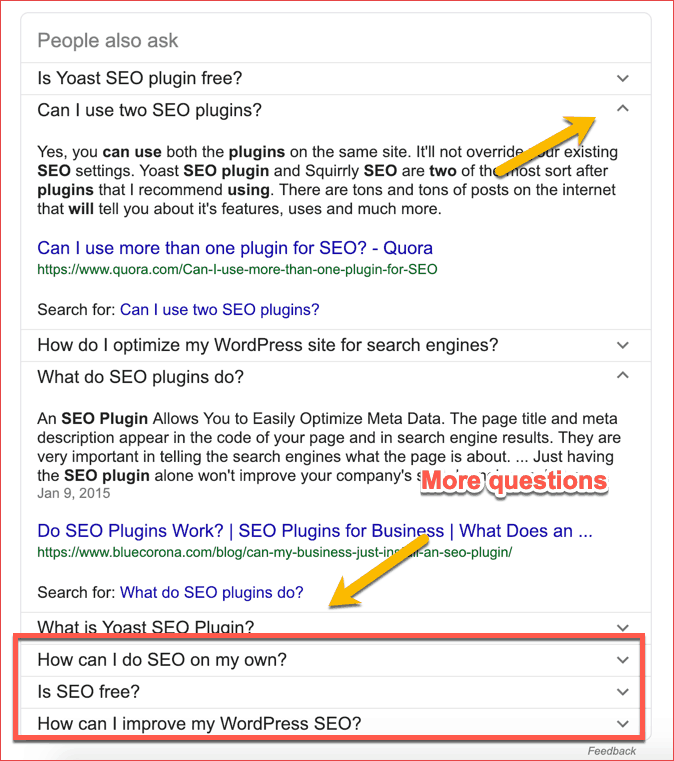
1. Post Title and Meta Title
- Post title: How your reader sees the title of the post on your website.
- Post meta title: How search engines show your post in search results.
- It is important to have your keywords in the meta title.
2. Post Meta Description
- In 156 characters, you need to add your keywords and create a description that is seductive enough for users to click on it.
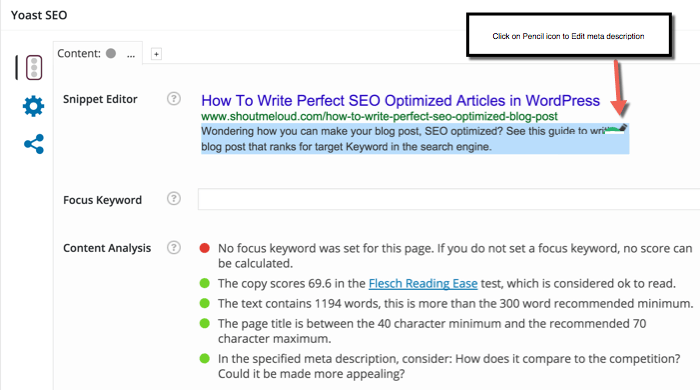
3. Image Alt Attribute

- Text is how Google recognizes an image.
- This is a huge mistake!
4. Interlink and Anchor Text

5. Remove STOP words from Permalink

- 3 Ways to Make a Blog Business Plan
- domain.com/3-ways-to-make-a-blog-business-plan.html
- Important Note: Never change your post permalink once the post is published.
6. H1, H2, H3 Headings
- Using proper H1, H2, and H3 heading tags.
- Research for keyword
- Identify the right word limit
- Scout Google to find the right format for your article
- Create an outline by analyzing the top 10 results
- Make a list of questions from “people also ask” section of the search
- Post title for readers & meta title for search engine (keywords in titles).
- Post meta description (optimize it for better CTR and use your target keyword once).
- Image Alt text (use keyword).
- Interlink within a post using good anchor text.
- Post permalink (remove stop words from permalink).
- Use proper heading tags (keywords in H1, H2, H3 tags).
3 specific steps to write SEO - friendly content from my experience of 5 years content writing.
What does an SEO-friendly article look like these days?
SEO, taste of audience SERP algorithm keeps changing with times. So keeping up with times is a big challange for content developers like us.
Ask 100 people and you will probably get 100 different answers. The problem is that a lot of marketing ‘experts’ are still stuck in the past when it comes to the best strategies for getting a post to the top of Google and this results in a lot of low quality content and a lot of wasted time.
The best way to make an article SEO-friendly is actually quite simple, so read on and let’s dive into what you need to know…
Provide Value — To understand how to write the best SEO-friendly article, it pays to get inside the mindset of Google a little. What is Google trying to achieve?
The answer is simple: it wants to serve its users by linking them to the very highest quality and most relevant content that it can find.
Thus, any signals that you can send to Google to show that your content is high quality and relevant, will ultimately results in a boost to your SEO. The question is just how you go about doing that.
One example is to include outward bound links to other useful resources, relevant to the content of your site. This shows Google that you’re interested in providing as much information as possible to your readers, it aligns you with high quality sites and it provides references to back up your claims (suggesting accuracy).
But what this shouldn’t mean is that ‘every article needs at least two outward bound links’. This is entirely missing the point as it will create a predictable pattern on your site that will look like manipulation. Link out when it is relevant and useful and don’t be cynical about it.
It’s also for this reason that Google likes to see long content – of around 800 words+. While reports vary, it is generally thought that the ideal content length for SEO is approximately 1,800 words – and this will improve your chances of being features as News.
Keywords — It’s painful to see, but some SEO companies still think that a good SEO article is one that has the same keywords repeated over and over, to the detriment of the reading experience. This is one of the fastest ways to have your content flagged as spam, if not by Google, then by the human readers on your site.
Instead then, keywords should be used very sparingly. A density of around 1-2% is recommended but only when that is appropriate and when it fits with the content naturally. This is one reason to write longer-form content though, as longer posts are going to have more space for repetitive keyword use.
It’s also important to recognize that synonyms and related terms are just as important, if not more so. Try to write around the subject and let related terms enter your content naturally. This is something you can expect to play a bigger and bigger role in future.
Readability — Finally, space out your content and use lots of headings. Use large fonts and a narrative, user-friendly structure. This will help to keep people on your pages for longer and that’s one of the other things that Google looks for when ranking content.
Do all this well and you’ll find that your content becomes much more engaging and that people stay on your site that much longer!
If you are finding digital marketing challenging and facing these specific obstacles in your career. Then you should train with us -
- You are a fresher, looking to get a good job in digital marketing. Don’t know how to train, where to look for quality training and certification.
- You are in some job you don’t love with 1–3 years of experience. You want to shift to digital marketing job.
- You are starting a business and want to start with digital marketing on your own.
In all above circumstances this course is perfect for you. Affordable too.
If you are looking to make a career in digital marketing / content marketing. We have taken inputs from 25+ top corporate recruiters and made this affordable course at only INR 2000 in digital marketing. Get discount of Rs. 100 by using “Digital5”
It all goes down to getting traffic to your website. Writing a beautifully crafted article is only halfway through, but getting people to read it completes the masterpiece. That is where Search Engine Optimization comes in. Writing Search engine friendly articles is one of the best ways to keep traffic to your website, as in the long run, only search engines can help you to get traffic from old articles.
When it comes to writing SEO optimized articles that will rank better in search engines you need to follow steps that are given. If you still need help or new to SEO you can hire an SEO company for the same:-
Post Title and Meta Title
Understanding the difference between a post title and a meta title is the starting point to a search engine friendly article.
The post title is how readers see the title of your article on your website, while the meta title is how search engines show your post in search results. If you did not specify a meta title for your article, your post title will be used for the meta title.
So make sure you decide if you want to keep the post title as your meta title or want them different. And also, don’t forget it is important to have your keywords in the meta title.
Meta Description
The Meta description plays a major role in search engine ranking. With platforms like WordPress and its robust plugins directory. Popular SEO plugin like Yoast will allow you to add meta descriptions to a post easily. The meta description should give away information on what your article is all about. Think of the meta description as a sales copy and don’t forget to include your keywords in this description.
Headings Tags
One of the most important aspects of SEO is the use of a proper heading tag. The most important tag is the <h1> heading tag, and by default, it will usually be the title of a post. For effective SEO writing, it is very necessary to use the h1, h2, & h3 heading tags, especially when writing a long post. It is also a good idea to use your keywords in H1, H2, and H3 tags.
Apart from the fact, the headings are important factors of SEO, Headings are great for breaking down articles into smaller, easy to digests parts. Making it easier for a visitor to want to read the article.
Interlink & Anchor Text
When writing a new article, it is always good practice to link back to old articles. This will make search engines to re-crawl these old articles and also make readers stay longer on your website. Interlinking helps reduces the bounce rate, another important SEO factor and also improves the navigability of your website.
Image Alt Attribute
While adding images to a post Catches the Eye of the reader, It is important to note that Images are also important for SEO.
Google can’t read images, the text is how Google recognizes images. It is important to use proper image names to ensure that search engines can understand what an image is about. When naming an image, don’t forget to keep the image name and alt (alternate text) attribute name relevant to the image itself.
When people make a search for an image on Google Image Search, they might end up landing on an image in one of your articles.
Permalinks
Permalinks are the permanent static hyperlink to a particular web page or entry in a blog. When writing an article, it is best practice to remove stop words from the article permalink. If you don’t remove these stop words, automatically the post title will be used as the permalinks
For example, when writing this blog post with the title: Steps To An SEO Optimized Article.
By default, the permalink will be: …/steps-to-a-seo-optimized-article/.
“To” and “A“ are stop words in the example above. In other to remove these stop words, you have to edit the permalinks.
This is how the edited permalinks will look:- …/steps-seo-optimized-article/.
The permalink is a good place to include your keyword. Once the post is published, Never change your post permalink.
The most effective way to attract web traffic to your blog posts is by making them a search engine friendly as possible.
In the longer run, Search Engine Optimization is what helps you pull traffic from previously published posts.
The quality of a blog is what predominantly determines its pull. Each blog post can be compared to a web page as far as search engine rankings are concerned. Therefore, each post can be made keyword rich to optimize its search engine ranking.
Let’s now find out how you can write SEO-optimized articles:
Meta Title and Post Title
A lot of writers think that meta title is the same thing as the post title. But that’s far from true. The post title is typically how your readers view your post’s title and meta title is the way in which search engines like Google display your post as search results. If you wish for your post and meta title to be the same, you have the option of not specifying latter in the Search Engine Optimization settings. However, remember that you have a keyword-rich meta title to have a good SEO rank.
TIP: Do not exceed 66 characters while writing post titles
Post Meta Description
You can add meta descriptions through most SEO plugins. Meta description has a primary role to play in SEO rankings. It provides you with 156 characters to add keywords that make your description attractive enough for viewers. If you missed out on adding meta descriptions to your previously published posts, go back to them and add one now. By doing so, you will ensure that your posts drive maximum online traffic to your website.
Image Alt Attribute
Image names are crucial in posts as Google does not recognize images, so make sure that you have proper image names when you upload photos. Do not commit the SEO blunder of uploading an image by the name of image002.jpg or the like. Give a name to your picture that makes it easy for search engines to push the image in search results.
TIP: Use a plugin like SEO Friendly Image to help people land on one of your blog posts when they search for an image on Google. If you do not wish to choose a plugin, alt attributes can also be added manually.
Anchor Text and Interlink
Each time you add a post to your blog, try to link it back with an older blog post. This helps the reader stay glued to your website for a longer duration and also lets search engines up the ranks of the old posts. This, in turn, reduces the bounce rate and adds to the SEO rankings. Try to create anchor text while creating interlinks. You will get an option that permits you to add a title as well as a link when you link to an older post. Ensure that you use primary keywords for the post you are linking to, to fill out the “Post Title” column.
Permalinks
This step requires you to remove all “stop words”. While writing a blog post, the post title is often full of stop words. For instance, if the title of your post is “5 ways to become a rich businessman”, your default permalink will be http://domain.com/5-ways-to-become-a-rich-businessman.html. In this case, words like “to” and “a” will be considered as stop words. You have an option to edit the permalink and modify it such that it becomes “Become-Rich-Businessman”, hence eliminating the unnecessary stop words.
TIP: Make changes to your permalink before you publish your post. Never edit the permalink once your post has been published.
Headings (H1, H2, H3)
One of the most significant facets of Search Engine Optimization revolves around the appropriate use of H1, H2, and H3 heading tags. As per the default settings, the title of the post uses an H1 heading tag, in all SEO-optimized themes. Therefore, for the next subheading, you must ideally use the H2 tag, and then the H3 tag and so on. This is extremely helpful particularly in the case of long posts where the reader may find it difficult to understand long pieces of data or information. Breaking the content into parts helps in increasing the attention span of the reader and also helps him understand the content better. Thus, the proper utilization of heading tags can go a long way in ensuring a good SEO ranking.
Summary
- Post titles are for readers, while meta title is for the search engines
- Optimize post meta description by using the target keyword
- Use a keyword to name your images (Image Alt text)
- Use an effective anchor text to link your current post with an older blog post
- Eliminate all stop words such as a, an, to, the etc. from permalinks
- Use appropriate heading tags to create pockets of content that make it easy for the reader to understand long posts
Follow the above-mentioned steps to create blog posts that will not only attract online traffic but also generate potential leads by providing value to your target segment.
How To Write SEO Content: Beginner’s Guide:
What is SEO?
Search Engine Optimization is a technique used in web publishing to increase web page visibility and traffic for a higher ranking in search engines and more readers.
What are the 10 most important things you should know for writing content that ranks well in search and at the same time is useful for your readers?
Here are some very easy tips to write SEO friendly content that you can follow:
How To Write SEO Content:
1. Write content that is unique and original
Unique and original content does not necessarily mean that you have to propose something new or say something that no one said before.
It means that your text should not be an exact copy from some other website or online source.
2. Post Title
The post title is a significant component of an article because it’s simply what your readers see before they go ahead to read the post.
Maintain an attractive post title with a catchy keyword like best, top, killer, etc.
3. Headlines and Sub-Headers Matter
The headline is your site’s most significant heading, so it uses the H1 heading. By default, the post title utilizes an H1 heading tag for any SEO-Optimized theme.
4. Make it easy to share the content
Your content will rank better as a whole if Google can see it being shared on other sites.
5. Interlinking is good for SEO
Interlinking is a way to tell your readers what they might be interested in about your other posts.
I am a big fan of internal links and I always advise my clients to use internal linking in their articles/pages to create their own small webs within their websites.
6. Use image(s) and optimize them
Images are one of the best SEO elements that can safely place a keyword.
7. Write your article
- Break it up into short paragraphs with subheaders.
- Make sure it's grammatically correct with no spelling mistakes.
- Include the most important keywords and key phrases in titles and subheaders.
Key writing tips for good blog posts
Above all, your blog post has to be a good piece of writing! When starting a new blog post, many bloggers just start writing, typing whatever comes into their heads. While this may work for some people who have natural writing talents, others may need some help. Personally, I always follow these ‘rules’ when blogging.
1. Think before you write!
Think carefully about the message of your piece. What do you want to tell your readers or which central question do you want to answer? What’s the purpose of your article? And what do you want your readers to do at the end of the page? Write down the answers to these questions before you begin.
2. Devise a structure for your blog post
Start your post by creating a clear structure. Every post should have:
- some sort of introduction (in which you introduce your topic);
- a body (in which the main message is written);
- a conclusion (which should summarize the most important ideas or draw a conclusion).
Write down what you want to say in all three sections. You now have a kind of summary of your post. Now the real writing can begin.
3. Use paragraphs
Everybody uses paragraphs, but not everybody uses them well. Don’t start each new sentence on a new line, just because it looks nice. There should be a logical reason for starting a new paragraph. Each paragraph should have its own idea or subject. Ask yourself what the main idea of each paragraph is. You should be able to summarize that main idea in only one sentence. If you need more sentences, you simply need to use more paragraphs.
4. Use headings
Headings structure the whole page, so use them. They’re important not just for readability, but for SEO as well. Headings also help Google to grasp the main topics of a long post and therefore can help in your ranking. If you want people to find their way through your articles, you should use subheadings to lead people, help them scan your page, and clarify the structure of your articles. Make sure you use your keywords in some of the subheadings, but not in each and every one of them, as it will make the text clunky and unnatural, which will put people off reading further.
5. Use signal words
Signal words help people to scan through your text and grasp the main ideas. Let’s say, for example, that there are three reasons for people to buy your product. You should use signal words like: ‘first of all’; ‘secondly’ and ‘finally’. Also, words like ‘nevertheless’, ‘surely’ and ‘indeed’ give a clear signal to your readers. Readers will instantly get that a conclusion will follow after words like ‘consequently’, ’so’ or ‘for this reason’. Signal words are therefore very important to add structure to your text.
6. Let other people read your post
Before publishing your post, let someone else read it first. Ask them whether they understand the main concept of your post and invite them to correct any typos and grammatical errors.
7. Optimize the length of your article
Make sure your articles have a minimum of 300 words. Google likes long articles, however, if your article is too long, it might scare users away. The ideal article length is around 700 words. Also, as a general rule of thumb: try to put your search terms in about 1 to 2 percent of your text. So in an article of 300 words, you should mention your search terms 3 to 6 times throughout the piece.
8. Link to previous content
If you’ve already written content on the same topic as your current post, don’t forget to link these posts together. It will make your post stronger because you show some authority on the subject. As well as that, your link structure is also important for your Google rank. And of course, readers may be interested in reading these related posts too.
9. Add content regularly
Regularly adding new blog posts to your website tells Google that your website is alive. If it’s not an active website, Google will crawl it less often, and this might negatively affect your rankings.
10. Use our Yoast SEO plugin
The content analysis tool in our Yoast SEO plugin helps you write SEO-friendly blog posts. Start by choosing your focus keyword because this is the most important search term you want people to find this particular page for. Our plugin checks your post to see whether you have used the keyword in the right places and measures many other aspects of your writing. The most important ones are:
- It allows you to add a meta description.
- It analyzes your text and calculates the Flesch reading ease score, which assesses the readability of your article.
- It checks that you have used your keyword in 5 important locations: the article heading, the title of the page, the URL of the page, the content of the article and the meta-description.
- It checks for links and images in the article.
- It calculates the number of words and the density of use of the focus keyword in the article.
- It also checks if other pages on your website use the same focus keyword, to prevent you from competing with yourself.
“Content is King”
Content writers tend to write SEO friendly website content to get a huge audience for their company website. SEO friendly content refers to the original fresh content which helps their organization to acquire top ranking in the google page.
- First, research the contents by going through a certain sample website.
- Initial thing is to write the user catchy title, attractive tag lines, headings, subheading etc.
- Don’t rush the content in the single paragraph
- Instead split it into several sub-headings and each may contain four lines. The content has to be simple as well as unique.
- SEO friendly mainly refers to including the keywords in the title, the first paragraph of the content that leads to gain more traffic and lead to the lead generation.
- After finishing the content use grammar tools to check the grammatical error. There are many free tools available on Google. For example Grammarly
- Next important thing is to check the plagiarism. The SEO content writer main role is to give 100%plagirism free content. Plagiarism refers to copy content or duplicate content that are copied from other websites. There are lots of plagiarism tools available on Google. You may use paid as well as free tools. For example Small SEO tool, duplichecker, quetext(free trial after the trial you have to pay) etc.
- Use a google analytics tool to track the visitors.
Below are the tips with which you can make your article SEO friendly.
1. Create SEO Friendly URL -
URLs are important both for a user and search engines.
For users, URLs not only boost up the user experience but also make them understand what you are going to read about.
On the other hand, URL help search engines like Google, Yahoo, and Bing to understand what the page is all about and what is the context of the page.
Check out the - Definitive Guide on How to Create SEO Friendly URLs?
2. Post/Page Title
The post title is something that gets displayed in the search results along with the URL and meta description.
It is one of the significant ranking factors in Google Algorithm.
Some of the basic tips to optimize your page title are -
- Always try to include your target keyword (keyword that you want to rank for) in your post title.
- Use modifiers like Best, Cheap, Free to create attention.
- Use numbers if you have a list post. Example - 10+ Ways to …
3. Heading Hierarchy
Heading hierarchy works like breadcrumbs. It helps search engines to understand the structure of your article.
Firstly, headings should follow the proper hierarchy in a page or post.
H1 should be followed by h2 as a child element. You cannot keep h3 as a parent element and h2 as a child of h3. That might confuse search engine with the page structure and it will definitely hurt your website SEO.
Secondly, there should be only
- One h1 tag in a page,
- 3 or 4 or 5 h2 tags
You can use other headings tags accordingly in the same pattern.
Check out the image to understand it properly.
4. Meta Tags
Meta tags play a vital role in SEO.
Above image is a screenshot of Google search result.
Meta tags are used to display title, URL, and description of a page or post in the search result.
5. Media (Images and Videos)
Media like images and videos are important to create interaction which ultimately increases the stay time and reduces bounce rate.
Try to include relevant images and videos in your articles.
On the other hand, make sure you always optimize your images. Image Optimization is important because unoptimized images might increase your page speed and that ruins the user experience.
One more thing you should always remember that apart from optimization, you should always add alt tags, title text, and captions to describe your images both for user and search engines.
6. Unique & Quality Content
Content is King and user experience is everything for search engines.
Try to create unique and quality content instead of doing over-optimizations.
7. LSI Keywords
LSI stands for Latent Semantic Indexing. LSI determines the relevancy in your content. LSI makes Google understand about the search query.
For example, when Google crawls an article on APPLE, it tries to understand whether the post is about the fruit or the American company. And it does that by checking other keywords around it.
Say, if it found keywords like the iPhone and iPad in the same article, it will understand that it's about the company.
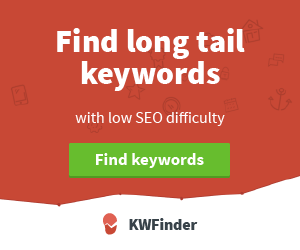


Comments
Post a Comment